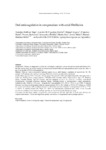Oral anticoagulation in octogenarians with atrial fibrillation

Use this link to cite
http://hdl.handle.net/2183/17273
Except where otherwise noted, this item's license is described as http://creativecommons.org/licenses/by-nc-nd/3.0/es/
Collections
- Investigación (FEP) [507]
Metadata
Show full item recordTitle
Oral anticoagulation in octogenarians with atrial fibrillationAuthor(s)
Date
2016-08-08Citation
González Saldivar H, Figueiras-Graillet LM, Anguita M, et al. Oral anticoagulation in octogenarians with atrial fibrillation. Int J Cardiol. 2016;223:87-90
Abstract
[Abstract] Background.
Vitamin K antagonists (VKAs) are still largely employed, even in nonvalvular atrial fibrillation (AF). Our aim was to study the clinical profile of octogenarians treated with oral anticoagulation and to study the effect of age on the quality of VKAs anticoagulation.
Methods.
Data are from a prospective national registry in an adult Spanish population of nonvalvular AF. We included 1637 patients who had been receiving VKAs for at least 6 months before enrolment.
Results.
Mean age was 73.8 ± 9.4 years. Patients aged > 80 years (N = 429) had a high risk profile with higher risk of stroke and bleeding than younger patients; CHA2DS2-VASc (Cardiac failure, Hypertension, Age > 74, Diabetes, Stroke, Vascular disease, Age 65–74 years, and Sex category) 4.5 ± 1.3 vs. 3.5 ± 1.6, p < 0.001, HAS-BLED (Hypertension, Abnormal renal/liver function, Stroke, Bleeding history or predisposition, Labile international normalized ratio, Elderly (> 64 years), Drugs/alcohol concomitantly) 2.4 ± 0.9 vs. 1.9 ± 1.1, p < 0.001. Creatinine clearance was lower in octogenarians than in younger patients (54.3 ± 16.1 ml/min vs. 69.5 ± 23.7 ml/min, p < 0.001) and severe renal disease with creatinine clearance < 30 ml/min was more frequent in octogenarians (5.2% vs. 2.2%, p < 0.001). In patients treated with VKAs (N = 1637), the international normalized ratio values of the 6 months previous to enrollment were similar in all age quartiles, as was the time in the therapeutic range.
Conclusion.
In this large registry octogenarians with nonvalvular AF had high risk of stroke and bleeding and frequent renal disease. VKAs anticoagulation quality was similar in octogenarians and in younger patients.
Keywords
Atrial fibrillation
Time in therapetic range
Vitamin K antagonists
Age
Octogenarius
Time in therapetic range
Vitamin K antagonists
Age
Octogenarius






